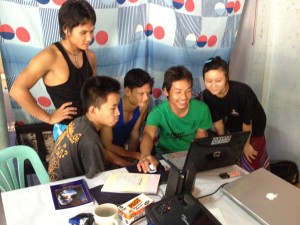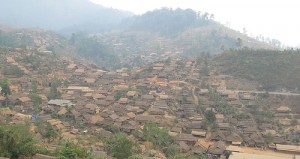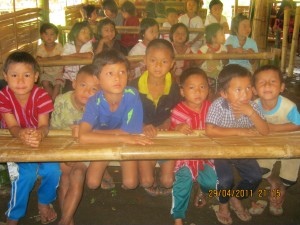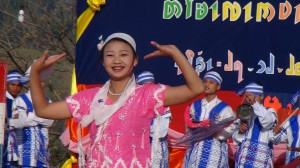Fires news; Karen New Generation School opening five round ceremony at KNU bridge seven control area.
Second news; If the KNU meet with the Burmese government this time , it will include with the talking about the public security.
Third news; Border Guard Force who were departed with DKBA, they celebrate their two years anniversary day ceremony at Shwe Ko Ko.
Four news; 40 percent of people in Nuh Poe refugee camp were moved outside the camp and spread to other places.
Five news; UNHCR and MOI have a plan to collect the refugees who were their family remaining in camp and have departed with their family who were in third country to reunion or relocation together.
Author Archives: hsaksaw
19 08 2012 Karen Border News
KSNG media activities update for May to July
At the begging of the month of July, our ksng media department had organized a media training course such as weekly broadcast news about the situation of Thai-Barman border. The aim and the objective of our training was to let the people know about the conflicts which happen after the ceasefire agreement, and will setup this news in to the online.
After our media training, our trainees went back to their camps and contact with us very closely every time, and also the Karen people who were in the other countries will listen to our weekly broadcasting programs. And in the online news Karen language (Kwekalu) in English side (Karen news) our program was take ten minutes long and most are in Karen language but some were had translated in English.
For the second course of KSNG’s Media training, we will continue to hold on September or October when the participator have free time or holiday time at school, because most of media training participator are students and school teachers who were in Thai-Burma border at Karen refugee camp.
For the next coming training, we will invite all of the old participator and the participator will discus and share their journalist work experiences in camp. They will also share their content person from difference camps or areas to get more self-confident in their work as a journalist.
2012,07,22 Karen Border News by KSNG
First News
Between Thai – Burma border the news said someone took the drugs and distrusted in Thailand. So there were a fighting between the group of the drugs sander and Thai security guide at the 16 of this month. And the eight of the drug sender were died and Thai security guide received the drug and it will cost more than one hundred million baths.
Second News
Most of the local people inside Burma at Karen state they know that there were many land mines remaining in their area, so they still afraid of the land mind and scared of that. Belong to this situation the local people had attack with the land mine and lost their leg and have to heal it, and the estimate was once a month, said mae toe clinic.
Third News
Villager said, In Karen state ,the Burma governments will provide the initiative development project , so they force and use the arm level to the villagers and took their cultivation and farm more than 800 yards for rebuilt the industries zones, so the villagers and the public facing with the very big problem by this case.
Fourth News
In Thai – Burma border at Karen refugee camps, last year the teacher who teach in the camps, they got their salary for each teachers received 400 baths , but this year for the increase of their salary till 700baths ,they must decrease vocational trainer project in their camps, said KRCEE.
Media Trainings Underway with the Karen Student Network Group
We began the first round of media trainings on April 23 at KSNG’s office in Mae Sot, Thailand. There are 13 talented young students attending, coming from several of the refugee camps along the Thai-Burma border, as well as a few from Karen State in Burma. This is actually more people than we expected, but we invited a few extra students who wanted to participate. KSNG’s office has become the home and workspace for these students during the training, the first round of which will be completed by May 18th.
During this first round of training, we focused on four topics: news writing, audio recording & editing, and broadcast. It’s been really exciting watching these students improve their skills, and learn entirely new ways to tell their stories. While KSNG’s media staff runs most of the trainings, we also invited two specialist, Aung Nai, who works for Internews and Jack Chance, an experienced radio producer and media trainer. In addition to the workshops, we are also distributing some media equipment to students, including notebooks, media guidebooks, and audio recorders.
This is the first opportunity for many of our students to learn about audio recording and editing. Although they all have a passion for news and storytelling, for many of them, computers and even electricity are difficult to find in their areas. But most of them have picked up on the techniques and technology very quickly.
KSNG media Training
In 2012 we will hold the media training for two times. For the first Basic Journalist Training course will start on the 23rd of April to 18th of March 2012.
We here at the KSNG media team will encourage the young people in camps by holding bases journalist training and workshops to improve their skills to be able update local current news to better in the future. This training, we will choose the students from different area and we will hold this training in Thai-Burma border at Mae Sot . They can exchange and share their opinions with different situation from other refugee camps as well as taking place in the discussions and sharing their knowledge. During the training we will target completely writing news, produces audio program skills and present other useful skills. Continue reading
The 2012 Ceasefire
In January 2012 ceasefire talks between the Karen National Union and the Myanmar government were renewed, although there are still reports of Burmese attacks on Karen villages, as well as an escalating violence in Kachin State. Most Karen cautiously welcome the ceasefire agreement, but there is much concern for how reconciliation will affect the Karen population, especially with so many of our people now living outside of our traditional homeland in Karen State. In refugee camps, many distrust the Burmese military (which has a constitutionally mandated majority in the new Myanmar Parliament). Karen who have fled their homes are worried about how they will be able to go back; ethnic land rights is certain to become a new struggle, with the Myanmar government eager to have sanctions lifted and foreign investors knocking on the door
Refugees and Internally Displaced Persons
During this time, and especially since the early 1980s, ethnic people sought refuge in the jungles as internally placed people or across the border in Thailand. Populations fluctuate as new refugees arrive and others are given resettlement options in third countries, but an estimated 150,000 Burmese refugees live in these seven camps today, with nearly half of them from the Karen ethnic group.
These are some of the longest running refugee camps in the world, second only to those in Palestine. Thailand does not officially recognize refugees (It is not signatory to the 1951 UN convention), so refugees in the Thai camps do not have freedom of mobility or opportunities for work or higher education.
Life in the camps is quite boring and recent opportunities for resettlement to third countries (such as Australia, Canada, and the US) have tempted many Karen and Burmese refugees to leave the camps to try for new lives away from both the conflict and their traditional communities.
Meanwhile across the river in Burma, an estimated 450,000 Internally Displaced Persons remain in hiding (again perhaps half of them Karen), having fled attacks on their villages by the Burmese military, but afraid or unable to cross the border into Thailand. These IDPs are incredibly vulnerable, both to human rights violations (rape and forced labor by the military, destruction of crops and property, a high risk of landmine injuries) as well as malnutrition and disease brought on by a life lived hiding in the jungle to avoid the conflict.
A Brief History of the Karen People
The Karen people are considered to be the largest of more than a dozen ethnic minority groups in Burma. During the second World War, Karen soldiers fought alongside the British army and Allied forces against the occupying Japanese but also against many ethnic Burmen nationalists, who favored independence from British colonial rule.
Karen and other ethnic minorities were promised autonomy after the war, a promise quickly forgotten once Burma became independent of colonial rule in 1948. Provisional agreements with ethnic minority groups were ignored by the new Burmen-dominated government. This prompted many of the ethnic groups fighting an insurgency for political autonomy, a conflict that has lead more than six decades of civil war; the longest running war in the world.
Karen Student Network Group (KSNG) Biography
The Karen Student Network Group was formed in July 6th, 1996, on the assumption that students and youths must play a key role in the struggle for a free and democratic Burma and must be prepared as the future leaders. The purpose of the KSNG is to provide activities for Karen youths that will unite and mobilize them to fight against the current regime in Burma,which ahs excluded true representation of the Karen people in political processes.
KSNG is on of the first Karen student organizations in Karen history to organize youth into one large network group, instead of fragmented and isolated groups. Today, KSNG comprises ten student-working groups with a membership of over 3,000 students, and operates along the Thai-Burmese border. Most KSNG members live in the Karen refugee camps, while some live in Thailand and abroad. Continue reading







